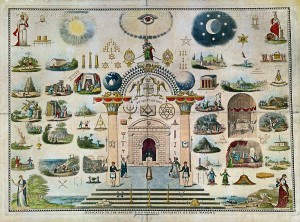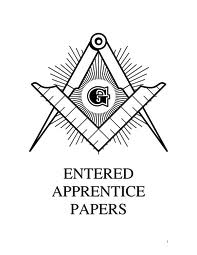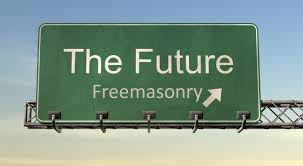SYMBOLISM
 One of the first things a candidate learns about Freemasonry is that it is “a beautiful system of morality, veiled in allegory and illustrated by symbols.” He learns that this is the answer to the question “What is Freemasonry?” But this is not a good answer for him to give to his friends when they ask him what Freemasonry is. How many of you have given this answer only to be greeted with blank stares? No, he is not told this in order to be able to answer the questions of those around him; he learns this answer in order that he may know to interpret what he has experienced, and what is to come, as allegory, and to look for the symbolism in Masonry.
One of the first things a candidate learns about Freemasonry is that it is “a beautiful system of morality, veiled in allegory and illustrated by symbols.” He learns that this is the answer to the question “What is Freemasonry?” But this is not a good answer for him to give to his friends when they ask him what Freemasonry is. How many of you have given this answer only to be greeted with blank stares? No, he is not told this in order to be able to answer the questions of those around him; he learns this answer in order that he may know to interpret what he has experienced, and what is to come, as allegory, and to look for the symbolism in Masonry.
What is symbolism? The Concise Oxford Dictionary says it is “the use of symbols to represent ideas” Well, that’s helpful!
So what is a symbol? The same dictionary says it is “a thing conventionally regarded as typifying, representing, or recalling something, especially an idea or quality.”
The word comes from the Greek “ballo” meaning “throw” and “syn”, meaning “together”. And so Bernard Jones says “A symbol, literally, is two things thrown together; one of them stands for or calls to mind a moral or spiritual truth.”
Using symbols to teach ideas has been used since the earliest of times. The pictures wrought in stained glass in the great cathedrals was a way to teach religious lessons to the illiterate, likewise the carvings on the ancient Hindu temples. Indeed hieroglyphs were originally pictures meant to record meaning. Only later did they come to represent certain sounds. The Hebrew alphabet had a similar origin. The Hebrew letter “beth” looks like a house, and that is what “beth” means. Only later did it come to represent the sound “b”.
But even a letter can come to have a meaning that is not a sound. What does it mean to see an “B” on the top of your paper? Does it mean your teacher was thinking of his house? What about an “X” beside an answer? By convention, certain letters have certain meanings.
Specialized groups develop symbols that mean something only to them. Mathematicians use certain Greek letters to mean certain things. They understand them, but the non-Mathematician does not.
So too with Masonry. We have developed certain symbols which mean something more to the Mason than to the non-Mason.
The ancient mystery cults used symbols to hide their secrets in the plain view of others. If you did not know the code, you would not get the message. But Masons do not use symbols to exclude knowledge from others. We do it to make it more accessible to ourselves. How can this be?
As Albert Pike says in Morals and Dogma, “The method of indirect suggestion, by allegory or symbol, is a more efficacious instrument of instruction than plain didactic language; since we are habitually indifferent to that which is acquired without effort.” If you have to work to find the meaning, you are more likely to remember it than if it is handed to you. And so we must work to figure out what the Masonic symbols mean.
But don’t work too hard.
M. W. Bro. David C. Bradley writes in Penetrating The Veil: “The words of the ceremonies often adequately reveal the symbolism and these explanations should be accepted as the correct definition. In many instances, however, the member is left to wrestle with his own interpretation. …. A word of caution is necessary. A member must not indulge in flights of fancy or travel to mystical extremes when interpreting symbolism. The simplest and most direct explanation is usually the best. The wise member does not permit his imagination to carry him into unreasonable fantasy nor into wild aberrations. It is this freedom of individual thought that provides the ritual with its vitality, because everyone has an opportunity to draw the conclusions that suit his individual needs. And this freedom to understand transcends barriers of language and allows members of any country to interpret a symbol. The ritual has a fascination for the member, who is sincerely trying to increase his knowledge of masonic philosophy by concentrating less on things that can be seen and touched and more on higher values and the quality of life.”
“Symbols are a means to an end. It is not the purpose of Freemasonry to teach the meaning of symbols; the sole purpose of symbolism is to teach Freemasonry. The importance of Masonic symbols is what these symbols teach. The symbolism of Freemasonry is inseparable from the philosophy of Freemasonry.”
M.W. Bro. Raymond S. J. Daniels
Sources:
- Bradley, David C., Penetrating The Veil, Masonic Holdings, Hamilton, Ont., 1997.
- Daniels, Raymond. S. J., “Let’s Talk Symbolism”, Com. on Masonic Education, GLCPOO, 2004.
- Dyer, Colin, Symbolism in Craft Freemasonry, Lewis Masonic, Surrey, U.K., 2003.
- Jones, Bernard, Freemasons’ Guide and Compendium, Harrap, London, U.K., 1986.
- Pike, Albert, Morals and Dogma, Jenkins, Richmond, VA., 1962.
- The Concise Oxford Dictionary, Oxford University Press, Oxford, U.K., 1990.






Very thought provoking Brother.